Walter Johnson: One of A Few Black Cyclists to Ride Bikecentennial 1976
Walter Johnson was an assistant leader during Bikecentennial (tours across the TransAm Bicycle Trail in the summer of 1976) and one of the few black individuals to ride that year. Bikecentennial made him realize that he doesn’t need much except for friendship.
Walter is considered an icon to some of his riding friends because he rode across the country, but we consider him a legend because he’s still an important part of his bike community, leading rides in his mid-eighties.
How old were you when you did Bikecentennial?
I was 40 years old and had been working for IBM in Philadelphia for 10 years. I had been biking as an adult for about four years.
What inspired you to do Bikecentennial?
I had a friend who, when he was in his teens, took the train to Montreal and rode his bike back to Philadelphia. I thought that was the most marvelous thing and wished that I could do the same. Years later, I read an article about Bikecentennial in Bicycling Magazine. Here was my opportunity to take an extended bike tour. The article said the government would match grants to help fund the planning of the route. I sent in $20 or $25. Later, they asked for more money, so I sent more. The year before Bikecentennial, I asked my manager at IBM if I could take eight weeks vacation to do the ride. He agreed and wrote a letter saying he approved my time off, which was lucky because I didn’t have the same manager in 1976 and my new manager probably would not have let me take that much time off.
I took the Leadership Training course in November of 1975 in Bowmansville, Pennsylvania. Dan Burden was there for at least part of it. I remember it was during Thanksgiving week, and on Thanksgiving Day we had turkey roasted in the fireplace at the Brickerville hostel. I met Elaine Becker and her now husband, Bill Schroder, also a B76 leader, during that Leadership Training course. I am still in touch with them today and have done a lot of riding with them over the years. After the Thanksgiving week training, I got a phone call or letter saying that I could be an assistant leader for a Bikecentennial group.
Before Bikecentennial, I had ridden from Philadelphia to Atlantic City, about 65 miles, and to Cape May, NJ, a bit over 100 miles and back on a Saturday and Sunday. I had also done some other 100-mile club rides and one 150 mile ride but nothing longer. I had also traveled to Europe, including France, Germany, and Italy, and had been to Atlanta, Dallas, Miami, and Montreal, but did not bike in any of those places.
Tell me about your group and your trip.
I only had eight weeks off from work, so I signed up for a fast west-to-east Bike Inn Group. We started from Reedsport, OR on May 25. We alternated riding a single day’s mileage with doing double day mileage in one day in order to get across the country in eight weeks instead of the normally scheduled twelve weeks. The planner did not consider the daily mileage on each day and as a result, one day we did only 35 miles and the next 140 miles.
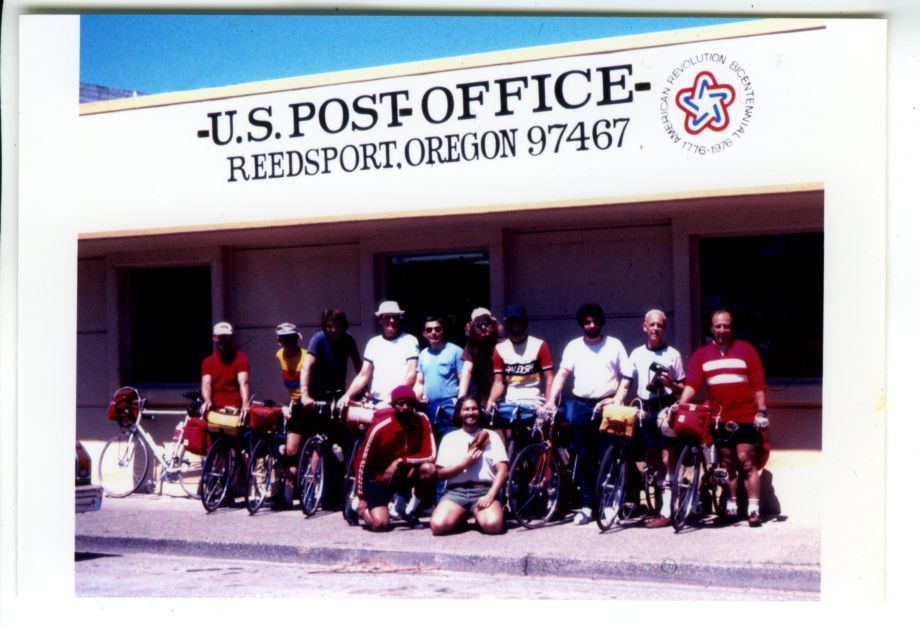
There were 13 people in our group, all men, including three men in their fifties and Arne, a 63-year-old Swede who was living in New Jersey. Arne was as dependable a rider as anyone. The worst rider was a 20-year-old. He didn’t have the strength to ride the mountains and started holding the rest of the group back. The rule was that one of the leaders had to be at the rear of the group, so John, the other leader, an electrician from California, said he would take care of the 20-year-old rider. After that, I essentially became the leader of the others. The group started doing their own thing in twos or threes, but they kept me aware of what they were doing each day.
We stayed in church basements, school gymnasiums, and small hotels along the way. We stayed in tipis in Idaho, small tents at Quake Lake, and a lean-to in Kentucky, but the rest were indoor accommodations. In Sinclair, Wyoming, in mid-June we stayed at a hotel that had been closed. They turned the heat on for us because it had snowed all day. I was quite frightened coming off that mountain into town because the snow would clog up in your brake blocks, making it very hard to brake. By the time we reached the Bike Inn, there were nearly two inches of snow on the ground.
On most days we ate five meals: a large breakfast, a mid-morning snack like a Danish or a sticky bun and coffee, a big lunch, an afternoon snack, often with ice cream, and dinner. We often negotiated our meals along the way. A restaurant in Oregon told us seconds on their salad bar were free. I told them, “Don’t tell the cyclists that,” knowing how hungry we were. But the owner insisted that it was their policy. The guys ate all of the salad at the salad bar and the restaurant had to buy more food for their regular customers. After that, I heard that the restaurant changed its policy for the other cyclists and started charging for seconds on the salad bar.
The third day into our trip, Marshall from South Carolina turned 58. We were near Eugene, OR. It was cold and it rained all day. We rode 10 miles on our way to reach a restaurant for breakfast and when we got there, it was closed. The next restaurant was 15 miles farther and when we got there, they were no longer serving breakfast and we would have to wait at least an hour for lunch. The owner had pity and phoned someone to bring food. She cooked eggs, bacon, toast, and coffee and only charged us $2 each. She even brought a cupcake for Marshall for his birthday.
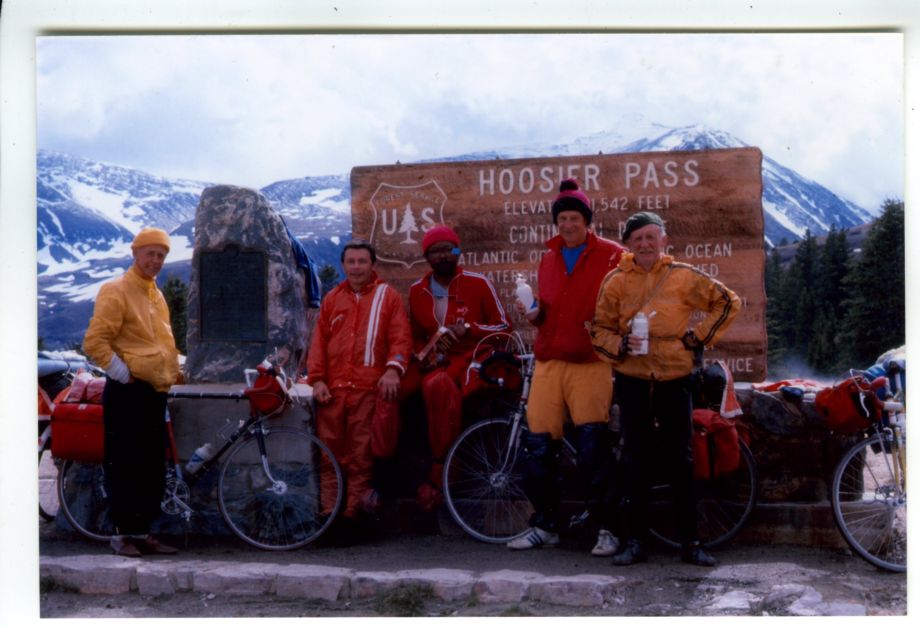
An independent rider, Theresa Whalen Leland, rode with us for a week from Missoula, Montana to Lander, Wyoming, where she left us to visit a friend. Theresa and I rode together much of that week. After I finished the route and was back in Philadelphia, Theresa sent me postcards and visited my family in Philadelphia in the fall of 1976 after she finished Bikecentennial. She had taken extra time off from her teaching job in the fall to tour the east coast. We still exchange Christmas cards.
Theresa was in the bicycle wheel photograph taken by Dan Burden. You can recognize Theresa because she is the one with the mirror on her glasses. I made that mirror for Theresa. We had been riding in Jackson Hole and we got caught in a thunderstorm. It was pouring rain, lightning and thundering. I was riding ahead of Theresa and cars were passing us every 15 to 30 seconds. At some point, I realized there were no cars coming by and Theresa wasn’t behind me anymore. Soon, I could see Theresa creeping down the road with about 20 cars behind her. I told her to get off the road so the cars could pass. She said she couldn’t see anything because her glasses were fogged up and that before she was riding close enough to me that she could use me as a guide to know where to ride. I rode slower so she could follow me the rest of way.
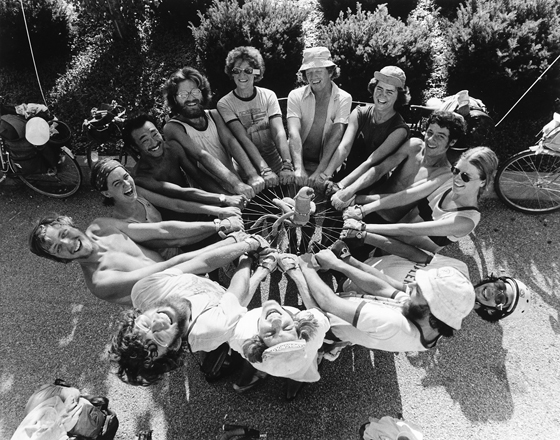
Aside from Theresa, I was probably closest to Arne. One day, in Kansas, Arne left 20 minutes before me after challenging me to beat him to our next Bike Inn. I knew I was a faster rider than Arne, but it took me more than four hours to catch him. He was sitting in front of a grocery eating a large sandwich. He told me I could buy a large roll, meat, cheese, and the grocer would add mustard and mayo and make a sandwich like he had. When I went into the store, he took off on his bike. I ate part of my sandwich and got back on my bike. An hour later, I caught up to Arne again and passed him. Later, I stopped at a post office to get my postal passport stamped. (A Postal passport was a booklet where you could get postmarks to show when you had been to that town. I was trying to get a stamp each day.) While I was in the Post Office, Arne passed me again and I had to chase him. Before we got into the town where we were staying, I got to a railroad crossing just before the crossing gates went down. Arne was stuck behind a long freight train. Several minutes later, Arne rode in and said to Michael, the Canadian with our group, that he was racing me and didn’t beat me but he made me sweat. He certainly did. It gave me a lot of respect for what I then considered “old”. And it gave me incentive to keep riding, being 17 years older than Arne was then.
Out of our group, I also spent a lot time with Terry, who was head of manufacturing at Utility Trailer Corporation in California. Terry and I had a lot of discussions about equal rights.
I only met one other black rider who was riding coast to coast. Someone from Bikecentennial called me after the ride to ask why I thought there were so few black cyclists. I told them economics is probably one reason. If you have a job, how can you afford to take two months off? I was able to do it because my manager gave me permission and I reached my teaching quota at IBM, even though I took so much time off, by doubling up on courses before and after my trip.
I was apprehensive about being a black man in the plains and having to deal with prejudice and racism. But I had a pragmatic feel about it. I thought, if I’m going to die, I’m going to die doing what I enjoy. During Bikecentennial, there were people who knew me just because I was black. Somewhere in Kansas, my tire got a flat. I was sitting on the road repairing the tire and a woman going west stopped and asked, “Do you need any help, Walt?” I thought, “How does she know my name?” It was a little bit scary to have someone in the middle of nowhere call you by name. In town that evening, a man joined us at dinner. I asked how the woman might know my name. Apparently, days earlier, someone in town came to check us out. They had heard about us and were afraid we were like a motorcycle gang. He told everyone in the small town, “There is this black guy named Walt who seems to be running the show and things seem to be going well.” I had been wearing a bright red warm-up suit with my name monogrammed on it above a Philadelphia patch. Some of the bikers called me Red Rider because of that suit.
Another time, Theresa and I were the first of our group who rode into Crowheart, Wyoming, which had just a grocery/post office/luncheonette, and a car repair shop. Theresa and I walked into the grocery store and the lady working there asked, “Where did you guys come from?” I had stopped shaving and had a scraggly beard. I probably looked a bit threatening. We told her we rode in on our bikes. She said she hadn’t heard any bikes and we said, “Bicycles don’t make any noise.” She replied, “Oh, bicycles! You are those bicyclists who are supposed to come through.” Just then, the car repair station guy came running in and asked, “What’s the matter?” She had alerted him because she thought we had sneaked up on her to rob the store. She realized her mistake and was very nice to us after that. She served us at the restaurant and when she was done, she took off her apron and helped us at the post office, too. Fortunately, I encountered no overt racism.
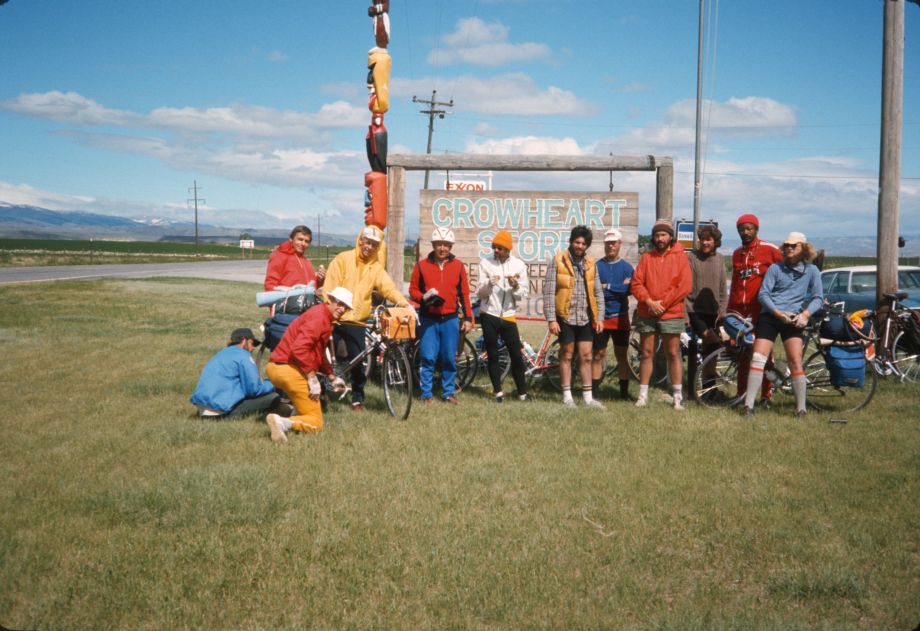
One of the things we heard was that we should watch out for the bears in Yellowstone. Bears are scary when you are on a bicycle. But our group never saw any bears until we got to the Blue Ridge Parkway in Virginia. There’s a four-mile climb up to the Parkway and we heard that it’s hard to get up the entire hill without stopping. About half way up, I saw a little bear — only about 18-20 inches tall. I kept going, but John stopped. I was intent on climbing those four miles without stopping. When John got to the top he asked me where I thought the bear’s mother was and I got the shakes realizing what could have happened if I had been between the cub and its mother. During the trip, we saw lots of elk, moose, deer, and even a herd of cattle. We saw eagles, snakes, and everything in between. The only bear I ever saw was that little cub in Virginia.
I was proud of our group of riders. Despite a few minor scrapes and repairable damage to a few bikes or other pieces of equipment, all 13 of us made it to the end of the trip.
How are you different because of your trip across the TransAmerica Trail?
The trip made me realize how little we really need. Two months with everything I needed on the bike made me realize that people, including me, have so much unnecessary stuff. All we really need is enough food, a warm and dry place to sleep, enough clothing to survive, something to interest your mind, and a few friends. Despite all the creature comforts and “luxuries” that surround me, what really makes my day, other than the necessities, are something new to learn or experience and friends. I think I may have surmised some of that before the two months on the bike, but the bike trip locked it in.
I got to see how vast and varied this country is. You could be in snow in mountains in June, like we were in Wyoming, and the next week it could be 100 degrees in the plains where it was the same scenery all day, nothing but wheat fields, oil pumps and cows. The towns were all about 40 miles apart and that was it. I had never ridden on a dirt road until we rode into a ghost town on a dirt or gravel road in Montana. I had never seen mountains like the ones in the West. It was enlightening to see what the country looked like. I became more aware and educated about how varied this country is.
I also had an experience I will never forget. And I have become an icon to some friends I ride with because they will tell people I rode across the country.
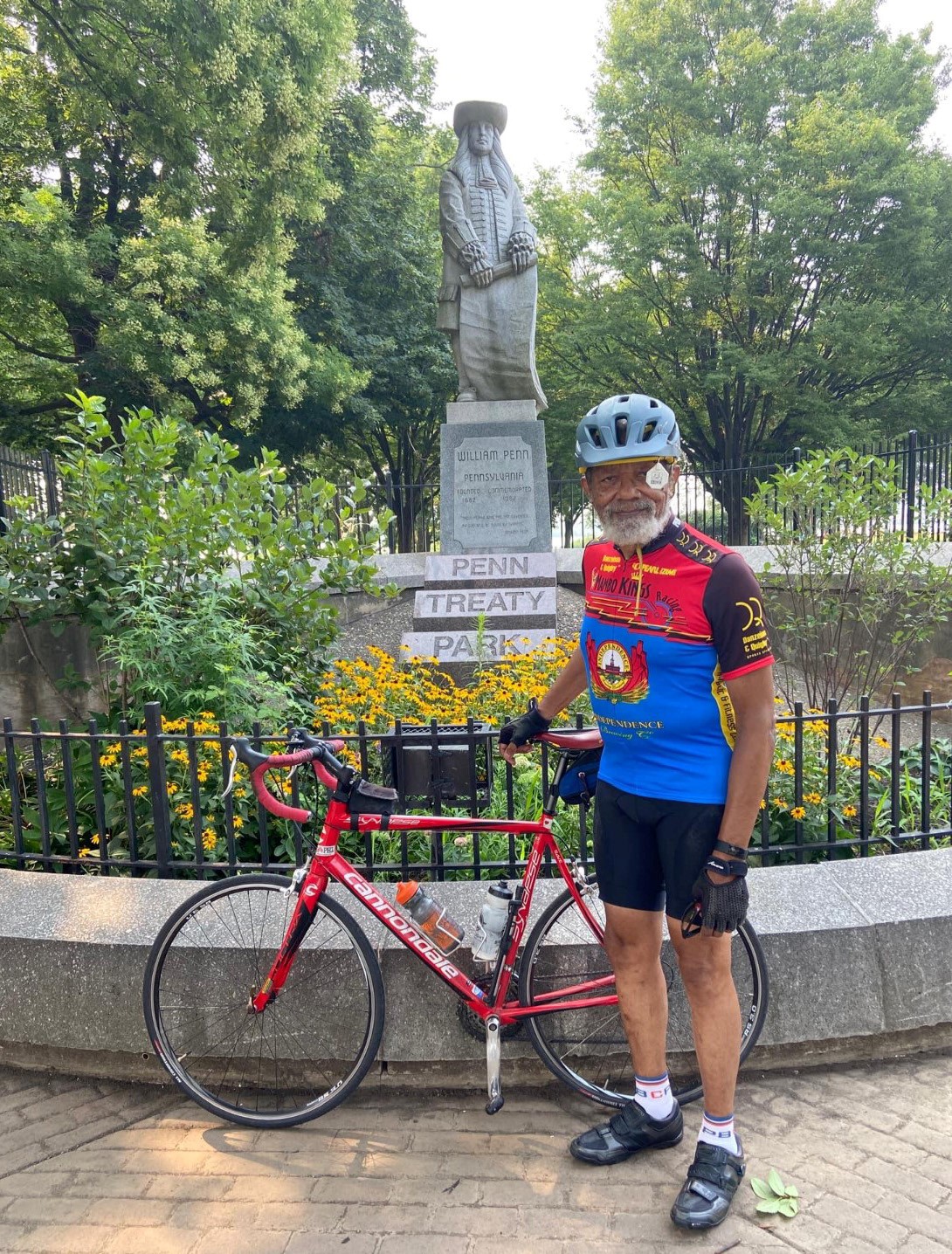
Which bike trips have you done since then and what’s still on your bucket list?
I haven’t gone on an extended tour since Bikecentennial. I’m just glad to be still riding. In my bicycle club of about a thousand members, I think I am the oldest active rider, although by less than a year. My longest ride this year was about 50 miles from home to Valley Forge National Park and back. It’s a pretty flat route, mostly on bike trails with no major hills. And I did it slowly so I wouldn’t burn out, rarely exceeding 11 mph. I led an 80K ride for my 80th birthday, after having led a 70 mile ride for my 70th. Friends are asking what I will do for my 90th. I have promised 90 furlongs. That’s only 11.25 miles. I am planning to do it. Wish me luck!
This blog post was originally published March 2016. It has been updated with new information from Walter Johnson in February 2023.

